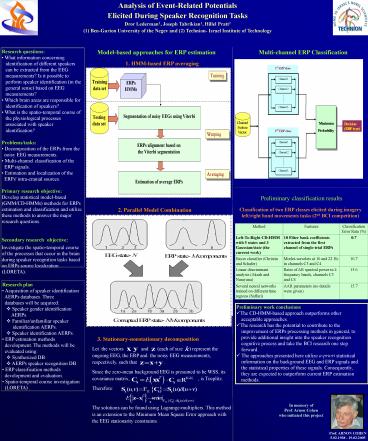Analysis of Event-Related Potentials - PowerPoint PPT Presentation
1 / 1
Title:
Analysis of Event-Related Potentials
Description:
Title: No Slide Title Author: Laura Larsson Last modified by: Lederman's Family Created Date: 5/12/1998 1:50:54 AM Document presentation format: Custom – PowerPoint PPT presentation
Number of Views:32
Avg rating:3.0/5.0
Title: Analysis of Event-Related Potentials
1
Analysis of Event-Related Potentials Elicited
During Speaker Recognition Tasks Dror Lederman1,
Joseph Tabrikian1, Hillel Pratt2 (1) Ben-Gurion
University of the Negev and (2) Technion- Israel
Institute of Technology
- Research questions
- What information concerning
- identification of different speakers
- can be extracted from the EEG
- measurements? Is it possible to
- perform speaker identification (in the
- general sense) based on EEG
- measurements?
- Which brain areas are responsible for
- identification of speakers?
- What is the spatio-temporal course of
- the physiological processes
- associated with speaker
- identification?
- Problems/tasks
- Decomposition of the ERPs from the
- noisy EEG measurements.
- Multi-channel classification of the
Model-based approaches for ERP estimation
Multi-channel ERP Classification
1. HMM-based ERP averaging
Preliminary classification results
2. Parallel Model Combination
Classification of two ERP classes elicited during
imagery left/right hand movements tasks (2nd BCI
competition)
Method Features Classification Error Rate ()
Left-To-Right CD-HMM with 5 states and 3 Gaussian/state (the current work) 10 Filter bank coefficients extracted from the first channel of single-trial ERPs 0.7
Bayes classifier (Christin and Schafer) Morlet-wavelets at 10 and 22 Hz in channels C3 and C4 10.7
Linear discriminant analysis (Akash and Narayana) Ratio of AR spectral power in 4 frequency bands, channels C3 and C4 13.6
Several neural networks trained on different time regions (Saffari) AAR parameters (no details were given) 15.7
- Research plan
- Acquisition of speaker identification
- AERPs databases. Three
- databases will be acquired
- Speaker gender identification
- AERPs.
- Familiar/unfamiliar speaker
- identification AERPs.
- Speaker identification AERPs.
- ERP estimation methods
- development. The methods will be
- evaluated using
- Synthesized DB.
- AERPs speaker recognition DB.
- ERP classification methods
- development and evaluation.
- Spatio-temporal course investigation
- (LORETA) .
- Preliminary work conclusions
- The CD-HMM-based approach outperforms other
- acceptable approaches.
- The research has the potential to contribute to
the - improvement of ERPs processing methods in
general, to - provide additional insight into the speaker
recognition - cognitive process and take the BCI research
one step - forward.
- The approaches presented here utilize a-priori
statistical - information on the background EEG and ERP
signals and - the statistical properties of these signals.
Consequently, - they are expected to outperform current ERP
estimation - methods.
3. Stationary-nonstationary decomposition
Let the vectors , and (each of
size ) represent the ongoing EEG, the ERP and
the noisy EEG measurements, respectively, such
that . Since the zero-mean
background EEG is presumed to be WSS, its
covariance matrix, ,
, is Toeplitz. Therefore T
he solutions can be found using
Lagrange-multipliers. This method is an extension
to the Minimum Mean Square Error approach with
the EEG stationarity constraints.
In memory of Prof. Arnon Cohen who initiated
this project
Prof. ARNON COHEN 5.02.1938 - 19.02.2005































